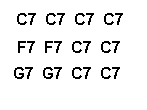The song You can’t beat the House of Mark Knopfler’s latest album Get Lucky is a traditional sounding blues song, reminding of some Chicago blues. However, something in its chord scheme sounds somewhat surprising and fresh, so I had a closer look at the chords and the structure of the song.
You can’t beat the house is based on a standard 12-bars blues scheme. Of course there is not only one blues scheme, but many common variations. If you try to break it down to the very basics, the following 12-bar scheme seems to be the purest blues scheme (here in the key of C major):

Compared with this, the first verse of You can’t beat the house runs over the following scheme:

Everything is quite normal up to bar 5, where an additional 2/4 bar (red) is inserted before the change to the subdominant (IV) chord, the F7. This chord goes together with the line of the lyrics which says “you can’t beat the house”. It is totally unexpected and thus has a surprising effect. Generally, inserting 2/4 bars into a 4/4 song is one of THE typical elements of Mark Knopfler’s songwriting, a topic to be covered with a future blog article.
The second change to the original scheme affects the 9th bar of the original scheme: the first G7 (change to the dominant chord) is substituted with a C7 (blue colour) here.
The second verse and the last verses are almost identical to the first with one exception, the 9th bar is left out:

As you see, we don’t have a 12-bar scheme anymore but a 12.5-bar scheme in the first and an 11.5-bar scheme.
The solos are over the standard blues scheme as in the first figure. Just to make it complete, the bridge (from 2:00 to 2:18) is just over a C chord.

One thought on “Mark Knopfler – You can’t beat the house – Variations of the standard blues scheme”
Yes, it surprised me at the first listen. It sounded a bit like mistake. (take “one” ?)
It reminds me a bit of some JL Hooker blues schemes. But the difference was that JLH played often alone, so it didn’t really matter how much bars he counted, and I’m almost sure that he didn’t “wrote” the number of bars somewhere, he just played with his feeling and changed chords when he wanted. If you listen to JHL recordings, you will hardly find classic 12-bars blues, but often 6,8,9,15 or whatever bars blues.
But here, Mark is playing with a band, so the song structure must have been clearly decided before recording.
It’s a bit strange, because, when I listen to this song, I always wait the chord changes where it doesn’t come, andvice versa; and it gives me a strange feeling. I must admit I prefer listen to classic blues schemes played by SRV, EC, etc…
About songs that differ from standard blues, I love Red House by the great Jimi (especially the Winterland 68 version). It follows the basic chord progression, but the sounds, the scales used, the feeling are completely out this planet, it is blues and not blues, you know what I mean : “Jimi played the delta blues, but this delta was on Mars”